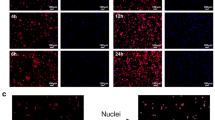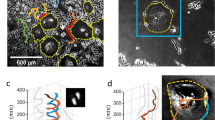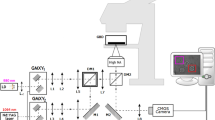Abstract
THE adhesive properties of cell surfaces which seem to determine many morphogenetic processes1 and which may be important in malignancy2 must reflect the biochemical characteristics of the cell surfaces. There have been attempts to isolate the macromolecules concerned by assaying for substances required for cell adhesion3, and one of us4 has described a promising experimental system for such studies. Trypsin-dissociated cells from an ascites-grown form of a mouse teratoma (teratocarcinoma, embryonal carcinoma)5,6 require L-glutamine in order to synthesize amino-sugars and to reaggregate in a solution of glucose and balanced salts, most probably because the amino-sugars are necessary for the formation of the complex carbohydrates involved in cell adhesion4. This communication describes experiments in which the amino-sugars are replaced by macromolecular substances in the ascites fluid in which the teratoma grew.
This is a preview of subscription content, access via your institution
Access options
Subscribe to this journal
Receive 51 print issues and online access
$199.00 per year
only $3.90 per issue
Buy this article
- Purchase on Springer Link
- Instant access to full article PDF
Prices may be subject to local taxes which are calculated during checkout
Similar content being viewed by others
References
Townes, P. L., and Holtfreter, J., J. Exp. Zool., 128, 53 (1955).
Coman, D. R., Cancer Res., 4, 625 (1944); Coman, D. R., Cancer Res., 21, 1436 (1961).
Humphreys, T., Devel. Biol., 8, 27 (1963); Humphreys, T., in The Specificity of Cell Surfaces (edit. by Davis, B. D., and Warren, L.), 195 (Prentice Hall, Englewood Cliffs, 1967).
Oppenheimer, S. B., Edidin, M., Orr, C. W., and Roseman, S., Proc. US Nat. Acad. Sci., 63, 1395 (1969).
Stevens, L. C., J. Nat. Cancer Inst., 20, 1257 (1958).
Kleinsmith, L. J., and Pierce, G. B., Cancer Res., 24, 1544 (1964).
Henkart, P., and Humphreys, T., Exp. Cell Res., 63 (in the press).
Lilien, J. E., Devel. Biol., 17, 657 (1968).
Orr, C. W., and Roseman, S., J. Membrane Biol., 1, 109 (1969).
Kuroda, Y., Exp. Cell Res., 49, 626 (1968).
Author information
Authors and Affiliations
Rights and permissions
About this article
Cite this article
OPPENHEIMER, S., HUMPHREYS, T. Isolation of Specific Macromolecules required for Adhesion of Mouse Tumour Cells. Nature 232, 125–127 (1971). https://doi.org/10.1038/232125a0
Received:
Revised:
Issue Date:
DOI: https://doi.org/10.1038/232125a0
This article is cited by
-
Sponge cell aggregation
Molecular and Cellular Biochemistry (1980)
-
Inhibitory effect of dibutyryl cyclic AMP and theophylline on the aggregation of human breast tumour cell line BT-20
Nature (1976)
-
Long-term tissue culture of epithelial-like cells from human skin (NCTC strain 2544)
Archives for Dermatological Research (1976)
-
Ultrastructural studies on the external surface coat of epidermal cells
Archives for Dermatological Research (1976)
-
Carbohydrate-binding protein from Polysphondylium pallidum implicated in intercellular adhesion
Nature (1974)
Comments
By submitting a comment you agree to abide by our Terms and Community Guidelines. If you find something abusive or that does not comply with our terms or guidelines please flag it as inappropriate.



